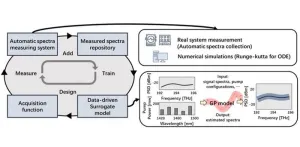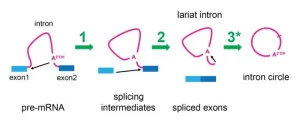(Press-News.org) Fezolinetant reduces the frequency and severity of hot flushes during menopause for 24 weeks, without serious side effects, according to research presented at the 26th European Congress of Endocrinology in Stockholm. These findings provide further evidence of the benefits of using this non-hormonal preventative drug in women experiencing hot flushes during menopause.
Hot flushes and night sweats, also known as vasomotor symptoms (VMS), affect up to 80% of women going through menopause and can severely impact daily life, exercise and sleep. Hormone replacement therapy (HRT) is the most effective treatment, but these drugs are not suitable for some women, such as survivors of endocrine cancer or those who have untreated high blood pressure; and others choose not to take them mainly due to the potential side effects.
The new type of non-hormonal drug, fezolinetant – approved by the US Food and Drug Administration (FDA) and the European Medicines Agency (EMA) last year – acts directly on the temperature-control pathway and alleviates these symptoms. Specifically, it works by blocking a brain protein called neurokinin-3 (NK-3), involved in regulating body temperature. But unlike hormone therapy which replaces estrogen, fezolinetant will not alleviate other menopausal symptoms such as mood changes or vaginal dryness.
Previous late-stage clinical trials (SKYLIGHT 1 and SKYLIGHT 2) have shown that fezolinetant reduces both the frequency and severity of hot flushes in women with moderate or severe symptoms compared to placebo over 12 weeks. This phase 3b study, known as DAYLIGHT and supported by Astellas Pharma, investigated the effect of fezolinetant use over 24 weeks.
Researchers examined 453 menopausal women aged 40–65 with moderate or severe hot flushes who were unsuitable for hormone replacement therapy, after giving them 45mg of fezolinetant or placebo, and found that women who took fezolinetant had less frequent and severe hot flushes throughout the 24 weeks. Women taking fezolinetant had consistently fewer hot flushes in the first week, with the strongest decrease during the first 3 days. The severity of their hot flushes was also reduced dramatically by the drug in the first week from the second day. No safety issues were found for the 45mg fezolinetant dose over the 24 weeks.
“DAYLIGHT is the first study of fezolinetant to investigate placebo-controlled efficacy over 24 weeks”, said Professor Antonio Cano from the INCLIVA Research Institute in Valencia, Spain, who was involved in the study.
“Fezolinetant was effective and well tolerated for 24 weeks and the effect was observed as early as day 1 of treatment. While there are other NK antagonists, none have shown a similar concurrence of efficacy and safety in clinical studies with a sufficiently high number of participants.”
“A safe and effective non-hormonal molecule may be available for the very high number of menopausal women who suffer from vasomotor symptoms and improve their overall health, quality of life and work performance. However, these symptoms vary in prevalence or intensity depending on ethnicity – for example, VMS are more frequent and severe in black women – so more clinical data are needed in different populations or geographical areas in the world.”
END
Late-stage study finds menopause drug fezolinetant safely reduces hot flushes for almost 6 months
2024-05-11
ELSE PRESS RELEASES FROM THIS DATE:
Arm fat may reveal women and men at risk of spinal fracture
2024-05-11
Measuring the total mass of fat in the arms could potentially predict which women and men over 50 are at risk of spinal fracture, according to research presented at the 26th European Congress of Endocrinology in Stockholm. The findings may help identify high-risk individuals with a more simple and inexpensive method and influence the design of their exercise plans.
Osteoporosis is a common disease among older people, but is also among the most undiagnosed and untreated medical conditions in the world. Many people do not have noticeable symptoms of osteoporosis until they experience an injury or fracture, which most ...
Study: Older adults with aggressive blood cancer are responsive to treatment and show prolonged survival
2024-05-11
MIAMI, FLORIDA (MAY 10, 2024) – Standard of care treatment for acute myeloid leukemia (AML) is safe and effective for adults over 80, according to a study published in Blood Neoplasia. For roughly a quarter of patients, this treatment can durably prolong survival.
AML is an aggressive and often deadly form of blood cancer that can be difficult to treat. For older adults with AML, the conventional treatment consists of a medication called venetoclax combined with a hypomethylating agent (HMA), also known as VEN-HMA. AML treatment is often intensive and can significantly suppress the immune ...
Craft-based firms can project authenticity through credibly and visibly communicating their identity — but not through overt means
2024-05-11
Consumers are drawn to authenticity when it comes to craft-based firms, and a new study published in the Strategic Entrepreneurship Journal explores what factors can help give credence to such a quality.
The study, authored by Stanislav D. Dobrev of the University of Wisconsin-Milwaukee and J. Cameron Verhaal of Tulane University, looked at how managers in identity-driven markets are challenged to maintain their authenticity as their company’s scale of operations expands. In such craft industries, the authors note, ...
Size of a person’s fat cells may hold clues to their future weight
2024-05-11
New research being presented at the European Congress on Obesity (ECO) in Venice, Italy (12-15 May) suggests that it is possible to predict if someone is going to gain weight based on their size of their fat cells.
Individuals with large fat cells tend to lose weight over time, while those with small fat cells gain weight, the Swedish study found.
The size and number of fat cells are known to determine fat mass – how much body fat someone has. But their impact on long-term changes in body weight are unknown.
To explore this further, Professor Peter ...
Do sex differences in how adipose tissue responds to insulin explain why type 2 diabetes is more common in men?
2024-05-11
New research being presented at the European Congress on Obesity (ECO) in Venice, Italy (12-15 May), and published in the International Journal of Obesity, could help explain why type 2 diabetes is more common in men than in women.
“Previous studies have shown that men develop type 2 diabetes (TD2) at a younger age and at a lower weight than women and, overall, men appear to be at higher risk of the condition,” says lead researcher Dr Daniel P Andersson, at the Department of Endocrinology, Karolinska University Hospital Huddinge, Stockholm, Sweden. “One reason for ...
Poor muscle health is common in people living with obesity – and increases the risk of an early death, Swedish study of people in UK finds
2024-05-11
New research being presented at the European Congress on Obesity (ECO) in Venice, Italy (12-15 May) has found that poor muscle health is associated with a higher risk of an early death in people living with obesity.
Individuals with adverse muscle composition were up to three times more likely to die during the course of the study than those with healthy muscles, a Swedish study of people in the UK concluded.
“We found that just by looking at muscle composition we can predict which individuals with obesity are most likely to die during the next few years,” says lead researcher Dr Jennifer Linge, of AMRA Medical, ...
The American Journal of Health Economics releases a special issue on health equity
2024-05-10
The May 2024 issue of the American Journal of Health Economics collects articles on the topic of health equity. The edition was inspired in part by the COVID-19 pandemic, writes guest editor Mónica García-Pérez, and the ways in which that “health crisis exposed the sources of disparities among different US populations that affect access to health care, quality of care, and final health outcomes.”
Consisting of five papers, the issue devotes particular attention to the topics of “race/ethnicity, ...
Optical power evolution in fiber-optic networks: New framework for better modeling and control
2024-05-10
With the emergence of internet services such as AI-generated content and virtual reality, the demand for global capacity has surged, significantly intensifying pressures on fiber-optic communication systems. To address this surge and reduce operational costs, efforts are underway to develop autonomous driving optical networks (ADONs) with highly-efficient network operations. One of the most important tasks for an ADON is to accurately model and control the optical power evolution (OPE) over fiber links, since it ...
Therapeutic opportunities for hypermutated urothelial carcinomas beyond immunotherapy
2024-05-10
“These results argue that combinations based on immunotherapy may also provide an opportunity for targeting urothelial cancers with low TMB, and provide efficacy superior to classic chemotherapy.”
BUFFALO, NY- May 10, 2024 – A new editorial paper was published in Oncoscience (Volume 11) on April 25, 2024, entitled, “Therapeutic opportunities for hypermutated urothelial carcinomas beyond immunotherapy.”
In this new editorial, researcher Ioannis A. Voutsadakis from Sault Area Hospital and Northern Ontario School of Medicine discusses tumor mutation burden (TMB)—a ...
UC Santa Cruz study discovers cellular activity that hints recycling is in our DNA
2024-05-10
By Rose Miyatsu, UC Santa Cruz Genomics Institute
Although you may not appreciate them, or have even heard of them, throughout your body, countless microscopic machines called spliceosomes are hard at work. As you sit and read, they are faithfully and rapidly putting back together the broken information in your genes by removing sequences called “introns” so that your messenger RNAs can make the correct proteins needed by your cells.
Introns are perhaps one of our genome’s biggest mysteries. They are DNA sequences that interrupt the sensible protein-coding information ...



